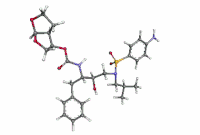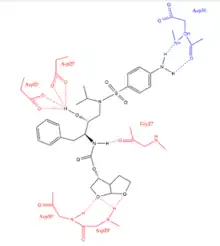Darunavir
 | |
 | |
| Names | |
|---|---|
| Trade names | Prezista, Prezcobix, others[1] |
| Other names | TMC114, DRV, darunavir ethanolate |
IUPAC name
| |
| Clinical data | |
| Drug class | Protease inhibitor (PI)[1] |
| Main uses | HIV/AIDS[1] |
| WHO AWaRe | UnlinkedWikibase error: ⧼unlinkedwikibase-error-statements-entity-not-set⧽ |
| Pregnancy category | |
| Routes of use | By mouth |
| Defined daily dose | 1.2 grams[3] |
| External links | |
| AHFS/Drugs.com | Monograph |
| MedlinePlus | a607042 |
| Legal | |
| License data | |
| Legal status | |
| Pharmacokinetics | |
| Bioavailability | 37% (without ritonavir), 82% (with ritonavir) |
| Protein binding | 95% |
| Metabolism | Liver (CYP3A4) |
| Elimination half-life | 15 hours |
| Excretion | Feces (80%), urine (14%) |
| Chemical and physical data | |
| Formula | C27H37N3O7S |
| Molar mass | 547.67 g·mol−1 |
| 3D model (JSmol) | |
SMILES
| |
InChI
| |
Darunavir (DRV), sold under the brand name Prezista among others, is an antiretroviral medication used to treat and prevent HIV/AIDS.[1] It is generally recommended for use with other antiretrovirals.[1][4] It is often used with low doses of ritonavir or cobicistat to increase darunavir levels.[1] It may be used for prevention after a needlestick injury or other potential exposure.[1] It is taken by mouth once to twice a day.[1]
Common side effects include diarrhea, nausea, abdominal pain, headache, rash and vomiting.[1][4] Severe side effects include allergic reactions, liver problems, and skin rashes such as toxic epidermal necrolysis.[1] While poorly studied in pregnancy it appears to be safe for the baby.[2] It is of the protease inhibitor (PI) class and works by blocking HIV protease.[1]
Darunavir was approved for medical use in the United States in 2006 and in the European Union in February 2007.[1][5] It is on the World Health Organization's List of Essential Medicines.[6] The wholesale cost in the developing world is about US$66 per month.[7] In the United States it costs more than $200 per month.[8] The combination darunavir/cobicistat is available as a single pill.[9]
Medical uses
Darunavir is an Office of AIDS Research Advisory Council (DHHS) recommended treatment option for adults and adolescents, regardless of whether they have received HIV treatment in the past.[10] In a study of patients that had never received HIV treatment, darunavir was as effective as lopinavir/ritonavir at 96 weeks with a once-daily dosing.[11] It was approved by the FDA on 21 October 2008 for people not previously treated for HIV.[12] As with other antiretrovirals, darunavir does not cure HIV/AIDS.[13]
It is indicated for the treatment of human immunodeficiency virus (HIV-1) infection in adults and children three years of age and older when co-administered with ritonavir, in combination with other antiretroviral agents.[4][5]
Dosage
The defined daily dose is 1.2 g (by mouth).[3] In those who weight more than 34 kg the dose is 800 mg once a day if no prior PI use and 600 mg twice per day if prior PI use.[14]
In those who weight 14 to 35 kg with no prior PI use the dose is 600 mg once per day.[14] In those who weight 25 to 35 kg with prior PI use the dose is 400 mg twice per day and in those who weight 14 to 25 kg the dose is 375 mg twice per day.[14]
Side effects
Darunavir is generally well tolerated. Rash is the most common side effect (7% of patients).[13] Other common side effects are diarrhea (2.3%), headache (3.8%), abdominal pain (2.3%), constipation (2.3%), and vomiting (1.5%).[13] Darunavir can also cause allergic reactions, and people allergic to ritonavir can also have a reaction to darunavir.[13]
High blood sugar, diabetes or worsening of diabetes, muscle pain, tenderness or weakness, and increased bleeding in people with hemophilia have been reported in patients taking protease inhibitor medicines like darunavir.[13] Changes in body fat have been seen in some patients taking medicines for HIV, including loss of fat from legs, arms and face, increased fat in the abdomen and other internal organs, breast enlargement, and fatty lumps on the back of the neck. The cause and long-term health effects of these conditions are not known.[13]
Drug interactions
Darunavir may interact with medications commonly taken by people with HIV/AIDS such as other antiretrovirals, and antacids such as proton pump inhibitors and H2 receptor antagonists.[13] St. John's wort may reduce the effectiveness of darunavir by increasing the breakdown of darunavir by the metabolic enzyme CYP3A.[13]
Mechanism of action

Darunavir is a nonpeptidic inhibitor of protease (PR) that lodges itself in the active site of PR through a number of hydrogen bonds.[15] It was developed to increase interactions with HIV-1 protease and to be more resistant against HIV-1 protease mutations. With a Kd (dissociation constant) of 4.5 x 10−12 M, darunavir has a much stronger interaction with PR and its dissociation constant is 1/100 to 1/1000 of other protease inhibitors.[16] This strong interaction comes from increased hydrogen bonds between darunavir and the backbone of the PR active site. Darunavir's structure allows it to create more hydrogen bonds with the PR active site than most PIs that have been developed and approved by the FDA.[17] Furthermore, the backbone of HIV-1 protease maintains its spatial conformation in the presence of mutations.[18] Because darunavir interacts with this stable portion of the protease, the PR-PI interaction is less likely to be disrupted by a mutation.[17]

Catalytic site
The chemical activity of the HIV-1 protease depends on two residues in the active site, Asp25 and Asp25’, one from each copy of the homodimer.[19] Darunavir interacts with these catalytic aspartates and the backbone of the active site through hydrogen bonds, specifically binding to residues Asp25, Asp25’, Asp 29, Asp 30, Asp 30’, and Gly 27 (Figure 3). This interaction prevents viral replication, as it competitively inhibits the viral polypeptides from gaining access to the active site and strongly binds to the enzymatic portions of this protein.[15]
History
Darunavir was approved for use in the United States in June 2006 and for use in the European Union in February 2007.[20][21][22][23][22][5]
The development of first-generation clinical inhibitors was founded on creating more protease-ligand interactions through hydrogen bonding and hydrophobic interactions.[15] The first HIV protease inhibitor approved by the FDA was saquinavir, which was designed to target wild-type HIV-1 protease.[24] However, this inhibitor is no longer effective due to resistance-causing mutations on the HIV-1 protease structure. The HIV genome has high plasticity, so has been able to become resistant to multiple HIV-1 protease inhibitors.[25] Since saquinavir, the FDA has approved several PIs, including darunavir.[23]
Cost
In the US and UK, healthcare costs were estimated to be lower with boosted darunavir than with investigator-selected control protease inhibitors in treatment-experienced patients.[26]
See also
References
- 1 2 3 4 5 6 7 8 9 10 11 12 "Darunavir". The American Society of Health-System Pharmacists. Archived from the original on 10 November 2016. Retrieved 28 November 2016.
- 1 2 3 "Darunavir (Prezista) Use During Pregnancy". Drugs.com. 23 October 2018. Archived from the original on 20 December 2016. Retrieved 21 April 2020.
- 1 2 "WHOCC - ATC/DDD Index". www.whocc.no. Archived from the original on 21 January 2021. Retrieved 21 September 2020.
- 1 2 3 "Prezista- darunavir tablet, film coated Prezista- darunavir suspension". DailyMed. 6 June 2019. Archived from the original on 6 February 2019. Retrieved 21 April 2020.
- 1 2 3 "Prezista EPAR". European Medicines Agency (EMA). Archived from the original on 25 June 2019. Retrieved 21 April 2020.
 This article incorporates text from this source, which is in the public domain.
This article incorporates text from this source, which is in the public domain. - ↑ World Health Organization (2019). World Health Organization model list of essential medicines: 21st list 2019. Geneva: World Health Organization. hdl:10665/325771. WHO/MVP/EMP/IAU/2019.06. License: CC BY-NC-SA 3.0 IGO.
- ↑ "Darunavir". International Drug Price Indicator Guide. Archived from the original on 22 January 2018. Retrieved 28 November 2016.
- ↑ Hamilton, Richart (2015). Tarascon Pocket Pharmacopoeia 2015 Deluxe Lab-Coat Edition. Jones & Bartlett Learning. p. 69. ISBN 9781284057560.
- ↑ "Darunavir / Cobicistat". AIDSinfo. U.S. Department of Health and Human Services. Archived from the original on 3 March 2020. Retrieved 29 June 2018.
- ↑ Panel on Antiretroviral Guidelines for Adults and Adolescents (18 December 2019). "Guidelines for the Use of Antiretroviral Agents in Adults and Adolescents with HIV" (PDF). Department of Health and Human Services. Archived from the original (PDF) on 13 August 2020. Retrieved 21 April 2020.
{{cite journal}}: Cite journal requires|journal=(help)- Lay summary in: https://aidsinfo.nih.gov/guidelines/html/1/adult-and-adolescent-arv/37/whats-new-in-the-guidelines-.
{{cite web}}: Missing or empty|title=(help)
- Lay summary in: https://aidsinfo.nih.gov/guidelines/html/1/adult-and-adolescent-arv/37/whats-new-in-the-guidelines-.
- ↑ hivandhepatitis.com HIV and Hepatitis.com - Internet Web Site at the Wayback Machine (archived 2007-07-13), Efficacy and Safety of Boosted Darunavir (Prezista) Are Superior to Lopinavir/ritonavir (Kaletra) at 96 Weeks: ARTEMIS Trial, 2008-10-28, URL Efficacy and Safety of Boosted Darunavir (Prezista) Are Comparable to Lopinavir/ritonavir (Kaletra) at 96 Weeks: ARTEMIS Trial at the Wayback Machine (archived 2009-07-19).
- ↑ hivandhepatitis.com HIV and Hepatitis.com - Internet Web Site at the Wayback Machine (archived 2007-07-13), Darunavir (Prezista) Receives Full Traditional Approval, Dose Set for Treatment-naive Patients, Caution Urged for Pregnant Women, 2008-10-24, URL Inflammation and Coagulation Biomarkers Linked to Higher Risk of Death in Patients Who Interrupt Antiretroviral Therapy at the Wayback Machine (archived 2009-05-19).
- 1 2 3 4 5 6 7 8 "Drug Monograph, Prezista". Archived from the original on 11 November 2016.
- 1 2 3 "DARUNAVIR = DRV - Essential drugs". medicalguidelines.msf.org. Archived from the original on 28 August 2021. Retrieved 30 August 2020.
- 1 2 3 Leonis, G.; Czyznikowska, Z.; et al. (2012). "Computational Studies of Darunavir into HIV-1 Protease and DMPC Bilayer: Necessary Conditions for Effective Binding and the Role of the Flaps". J. Chem. Inf. Model. 52: 1542–1558. doi:10.1021/ci300014z.
- ↑ King, N. M.; Prabu-Jeyabalan, M.; et al. (2004). "Structural and Thermodynamic Basis for the Binding of TMC114, a Next-Generation Human Immunodeficiency Virus Type 1 Protease Inhibitor". Journal of Virology. 78: 21.
- 1 2 Lefebvre, E.; Schiffer, C. A. (2008). "Resilience to Resistance of HIV-1 Protease Inhibitors: Profile of Darunavir". AIDS Rev. 10 (3): 131–142.
- ↑ Lascar, R. M.; Benn, P. (2009). "Role of darunavir in the management of HIV infection". HIV AIDS (Auckl). 1: 31–39.
- ↑ Li, D.; Zhang, Y.; et al. (2014). "Investigation on the mechanism for the binding and drug resistance of wild type and mutations of G86 residue in HIV-1 protease complexed with Darunavir by molecular dynamic simulation and free energy calculation". J. Molecular Modeling. 20: 2122. doi:10.1007/s00894-014-2122-y.
- ↑ MacArthur, Rodger D (2007). "Darunavir: promising initial results". The Lancet. 369: 1143–1144. doi:10.1016/S0140-6736(07)60499-1.
- ↑ "FDA Approves New HIV Treatment for Patients Who Do Not Respond to Existing Drugs". U.S. Food and Drug Administration (FDA) (Press release). Archived from the original on 13 November 2016. Retrieved 10 November 2016.
- 1 2 "Drug Approval Package: Prezista (Darumavir) NDA #021976". U.S. Food and Drug Administration (FDA). 6 September 2006. Archived from the original on 1 July 2016. Retrieved 21 April 2020.
- 1 2 "HIV/AIDS Historical Time Line 2000 - 2010". U.S. Food and Drug Administration. 5 January 2018. Archived from the original on 1 June 2019. Retrieved 21 April 2020.
- ↑ Liu, F.; Kovalevsky, A.Y. (2008). "Effect of Flap Mutations on Structure of HIV-1 Protease and Inhibition by Saquinavir and Darunavir". J. Mol. Biol. 381 (1): 102–115. doi:10.1016/j.jmb.2008.05.062. PMC 2754059. PMID 18597780.
- ↑ Eron, J (2000). "HIV-1 Protease Inhibitors". Oxford Journal of Clinical Infectious Diseases. 30: 160–170.
External links
| External sites: |
|
|---|---|
| Identifiers: |
- Panel on Antiretroviral Guidelines for Adults and Adolescents (18 December 2019). "Guidelines for the Use of Antiretroviral Agents in Adults and Adolescents with HIV" (PDF). Department of Health and Human Services. Archived from the original (PDF) on 13 August 2020. Retrieved 21 April 2020. Lay summary.
{{cite journal}}: Cite journal requires|journal=(help); Cite uses deprecated parameter|lay-url=(help)